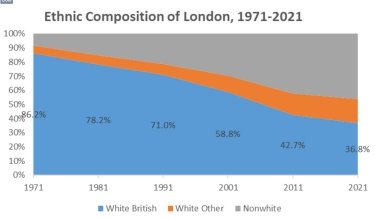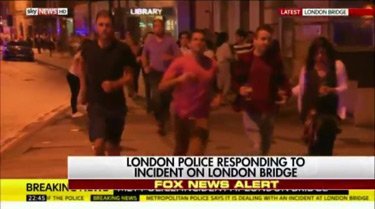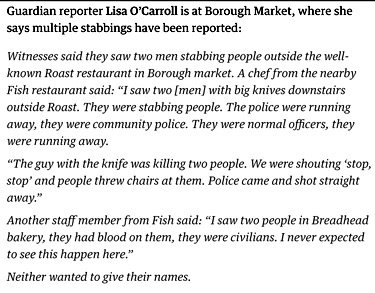A Pretty Amazing Statistic (Below)
Andrew Sullivan, Ideological Conformity, London, Racial Politics, Third World Immigration
Andrew Sullivan writes:
In 1971, the proportion of Londoners who were “White British” was 86.2 percent. Fifty years later, it’s 36.8 percent. That’s not a population change; it’s an entire paradigm shift.
Some of the friends I saw last week love this. “I cannot tell you how happy it makes me,” one told me, “that I can go around London and never hear English spoken!” And there are times I see her point: London is far more dynamic, diverse, and prosperous than it was in my childhood. I love much of it too — I’d much rather live in the London of 2021 than 1971 — and feel pride in my native land’s capacity to be so inclusive. But this is little short of a cultural revolution in a tiny, already densely packed island, which knew minimal immigration for centuries until the 1950s and 1960s.
Philip Larkin wrote a poem in 1972, “Going, Going,” about the pace of change in his native land:
It seems, just now,
To be happening so very fast;
Despite all the land left free
For the first time I feel somehow
That it isn’t going to lastHe was talking about putting economic and population growth before cultural and environmental stability, and not specifically about demographic change (though his views on the latter were similar, if not downright reactionary).
And that will be England gone,
The shadows, the meadows, the lanes,
The guildhalls, the carved choirs.But the change he lamented was utterly trivial compared with what is happening now, let alone what is now baked in for the next few decades. The phrase “great replacement” is rightly abhorred for its racist, anti-Semitic inspirations. Larkin eschewed any idea of a conspiracy of some kind:
Most things are never meant.
This won’t be, most likely;But an accidental revolution is still a revolution. And I would just ask those who rightly denigrate the term “great replacement” to provide an alternative phrase to describe a city which was 87 percent “White British” a half-century ago and 36 percent today? It’s the kind of demographic change only previously seen in other parts of the world in times of plague, invasion, or campaigns of ethnic cleansing.
And then I think of George Orwell’s passionate defense of Englishness, his fusion of that patriotism with socialism, his detestation of the kind of left elites who now foment not just demographic but cultural revolution out of hatred of the past, performative virtue-signaling and thinly veiled contempt for so many of their stodgier countrymen. I think of his conviction that “it needs some very great disaster, such as prolonged subjugation by a foreign enemy, to destroy a national culture.”
Orwell backed huge structural changes in British society in 1941 and yet insisted that a nation could retain its cultural integrity:
The Stock Exchange will be pulled down, the horse plough will give way to the tractor, the country houses will be turned into children’s holiday camps, the Eton and Harrow match will be forgotten, but England will still be England, an everlasting animal stretching into the future and the past, and, like all living things, having the power to change out of recognition and yet remain the same.
I hover between these two visions of pessimism and optimism as I watch the English-speaking world transform.
Let me offer a quotation of my own.
-
“Practically, What have you to recommend? I answer at once, Nothing. The whole current of thought and feeling, the whole stream of human affairs, is setting with irresistible force in that direction. The old ways of living… are breaking down all over Europe, and are floating this way and that like haycocks in a flood. Nor do I see why any wise man should expend much thought or trouble on trying to save their wrecks. The waters are out and no human force can turn them back, but I do not see why as we go with the stream we need sing Hallelujah to the river god.”
–James FitzJames Drephen, “Liberty, Equality, Fraternity,” 1874.
Andrew says that he hovers between pessimism and optimism, but that’s complete malarkey.
When today’s Trans-Atlantic Community of Fashion runs off the tracks, effects another atrocity, delivers “un autre jolie cadeau de la Révolution française,” you will always find Andrew in the front row of the media choir warbling Hallelujahs to the river god.
Andrew was once, long ago, professionally conservative, but he had another, deeper affiliation, and between Conservatism and Sodomy there was ultimately no contest. Going over to the other side was de rigeur for affiliates of Andrew’s subculture, and Andrew will never ever be found dying in defense of any hill assailed by what Curtiss Yarvon likes to call “the Cathedral.”
Andrew is glib. Andrew is clever. But Andrew is not tough.
It is enormously ironic that even timid little Andrew, with his fondness for performing ceremonial nods in the direction of his long-discarded conservatism was unfortunate enough to provoke the Woke Inquisition which brutally liquidated him from New York Magazine despite his in-the-end invariably reliable Gleichshaltung.
It just goes to show that the Revolution/”the river god” is a jealous and unkind deity.
The Elite Insanity is Trans-Atlantic
British Knife Laws, Hoplophobia, London, Sadiq Khan, Terrorism
Steerpike, in the London Spectator:
What an odd thing Sadiq Khan said following this morning’s stabbings in central London. Shortly before 10 a.m., three people were attacked by a man on a bike in Bishopsgate. The criminal is still at large, according to the Telegraph. This horrifying incident was no surprise to Londoners, so you would think that the Mayor would – from experience – strike the right chord. Instead, Khan had this to say:
“The good news is, it’s not a terror attack. And another piece of good news is the three victims of the stabbing are not in life-threatening situations, thank God. But it’s just a reminder of the dangers of carrying a knife…
Had anyone died this morning, would Khan really have suggested that it was ‘good news’ it wasn’t a terror attack? Just a regular stabbing? It’s not a thought Mr S thinks will be held by the families of those injured.
The Mayor also seemed to apportion blame to a sentient knife – and not, you know, the assailant. He continued: ‘We’ve seen this year, thankfully, we’ve actually seen a reduction in knife crime injuries, a reduction in knife crime injuries in those below 25.’ From a pretty high peak though, eh?
‘I’m determined to continue lobbying the government to reverse their cuts in policing and to reverse their cuts in young people,’ said Khan. Police budgets have, of course, increased by £3.8 billion since Khan took office.
Homeless Man Built His Own Secret Bunker
Dominic Van Allen, Hampstead Heath, London, The "Homeless"
Dominic Van Allen was not just a spaced-out junkie. He worked, but found it impossible to earn enough to pay London rents. So he improvised, and in the process demonstrated major amounts of initiative, enterprize, and ingenuity. Unfortunately, in the end, he became a victim of contemporary urban tyranny. He was accused of ownership of a crude pipe gun found buried in the ground and convicted. Unless his appeal succeeds, he won’t have to deal witrh homelessness for five years.
Thomas Hardy’s Tree in St. Pancras Churchyard
Headstones, History, London, St. Pancras Church, Thomas Hardy
Kuriositas has an interesting
In the churchyard of St Pancras Old Church in London, hundreds of old gravestones circle an ash tree. Of course, these were not how they were originally laid out. So, how did they get to this, their final resting place, as it were? And who was responsible?
Long before he became famous for novels like Tess of the D’Urbervilles, Far From the Madding Crowd and The Mayor of Casterbridge, Thomas Hardy (like any other aspiring writer) had to find employment with which to pay his way through the world. His chosen field was to be architecture.
However, it is unlikely that the would-be author could guess what one of his firm’s projects would demand of him. He probably didn’t sign up for architecture to then be sent to excavate a graveyard. Yet, like many a young man finding his path, sometimes you have to do what you have to do.
During his five years with the Covent Garden based architect Arthur Blomfield (1862-67) the railway system of the British Isles was undergoing a huge burst of growth. The lines in and around London were, in particular, demanding more room to carry people in and out of the capital.
It was during this time that an older part of St Pancras Churchyard was designated for almost total obliteration in order to make way for a new railway line. The Bishop of London gave the contract for this work to Blomfield who passed responsibility on to his young student, Hardy. Yet these objects in the way of progress could not be cleared like slums. Even progress occasionally must respect what came before and the removal and relocation of so many middle class graves would almost certainly have caused an uproar if it was not done properly..
The coffins were removed from the site with circumspection and care and were reburied elsewhere (the Victorian English had a horror of cremation). There was no need to move the headstones. Yet although the graves were old and unvisited it would not have been respectful to simply dump the headstones in to the Thames.
The process would have taken a great deal of time and young Hardy, who was 25 when he was given this commission would have spent the best part of a year overseeing the work. Perhaps his experiences in St Pancras church yard later informed some of the bleaker passages in his novels.
Some of the headstones were placed in a circular pattern around a young ash tree in the churchyard of St Pancras Old Church, far enough away from the site of the railway for them never to have to be disturbed again. Over the decades the tree has, inevitably grown and parts of the headstones nearest the tree have disappeared in to its growth.
Street Photography, Victorian London
History, London, Street Photography

Recruiting sergeants, 1877. “Quick, sign up! There’s still time to get there for Isandhlwana.”
At Kuriositas.
Complete book here.
More Statues in Danger
Bill de Blasio, Christopher Columbus, Horatio Nelson, Horatio Seymour, Left Think, London, New York City, Ulysses Grant

How much longer will Christopher Columbus look out over New York’s Columbus Circle?
Mayor de Blasio opened a historical can of worms Tuesday in his quest to rid the city of offensive monuments, ducking for cover when asked if Grant’s Tomb might be shuttered because of actions two centuries ago.
The mayor had no ready answers when pounded with questions about flawed historical figures, from Ulysses S. Grant to little-known former New York Gov. Horatio Seymour, who are being honored in the city.
Grant issued an order to expel Jews from three states during the Civil War while Seymour’s campaign slogan in 1868 was “This is a White Man’s Country; Let White Men Rule.â€
Monuments to Christopher Columbus have also sparked criticism over his treatment of native populations.
“We’re trying to unpack 400 years of American history here — that’s really what’s going on,†de Blasio said defensively.
“This is complicated stuff. But you know it’s a lot better to be talking about it and trying to work through it than ignoring it because I think for a lot of people in this city and in this country, they feel that their history has been ignored or affronts to their history have been tolerated.â€
Hizzoner at one point acknowledged he hadn’t considered whether the review should include portraits until the one of Seymour hanging inside City Hall was mentioned.
He also couldn’t say whether school names or other dedications would be reconsidered.
“To some extent the commission’s going to have to figure out what are the appropriate boundaries,†de Blasio said. “We may end up doing this in stages because this is complex stuff.â€
———————————
In the Guardian, Afua Hirsch is demanding that Britain follow the American example and remove Lord Nelson from his column in Trafalgar Square. Sure, Nelson won the battles of the Nile, Copenhagen, and Trafalgar, and prevented a Napoleonic Invasion of England, but, hey! what about the black contribution to British history?
We have “moved on†from this era no more than the US has from its slavery and segregationist past. The difference is that America is now in the midst of frenzied debate on what to do about it, whereas Britain – in our inertia, arrogance and intellectual laziness – is not.
The statues that remain are not being “put in their historical contextâ€, as is often claimed. Take Nelson’s column. Yes, it does include the figure of a black sailor, cast in bronze in the bas-relief. He was probably one of the thousands of slaves promised freedom if they fought for the British military, only to be later left destitute, begging and homeless, on London’s streets when the war was over.
But nothing about this “context†is accessible to the people who crane their necks in awe of Nelson. The black slaves whose brutalisation made Britain the global power it then was remain invisible, erased and unseen.
The people so energetically defending statues of Britain’s white supremacists remain entirely unconcerned about righting this persistent wrong. They are content to leave the other side of the story where it is now – in Nelson’s case, among the dust and the pigeons, 52 metres below the admiral’s feet. The message seems to be that is the only place where the memory of the black contribution to Britain’s past belongs.
47-Year-Old Soccer Fan Took on Three Knife-Wielding Terrorists Barehanded
London, Millwall Football Club, Roy Larner, Terrorism, The Right Stuff
The Telegraph reports that the England of Old is not quite dead.
A defiant football fan who charged at the three terrorists and took them all on with his bare hands has been nicknamed the Lion of London Bridge for his bravery.
Roy Larner, 47, was drinking in a pub when the three terrorists burst in and he held them off so others could escape, getting fairly cut up in the process.
They chanted “Islam, Islam” and “This is for Allah”.
In return, Mr Larner shouted: “I’m f—ing Millwall!!”
He was knifed eight times before the jihadis left the Black & Blue restaurant and bar.
His friends have since gifted him a “learn to run” book, joking about how instead of saving his own life, he put himself in danger by fighting the terrorists.
He told The Sun from hospital: “They had these long knives and started shouting about Allah. Then it was, ‘Islam, Islam, Islam’.
“Like an idiot I shouted back at them. I thought, ‘I need to take the p— out of these b——s’.â€
“I took a few steps towards them and said, ‘F— you, I’m Millwall’. So they started attacking me.
“I stood in front of them trying to fight them off. Everyone else ran to the back.
“I was on my own against all three of them, that’s why I got hurt so much.
Unarmed London Police Ran Away, Civilians Threw Chairs and Bottle at Terrorists Stabbing People
Hoplophobia, Islam, London, Terrorism
One eyewitness, named only as Gerard, told the BBC: “I saw a geezer lying on the floor saying he’d been stabbed
“I saw these three Muslim guys run up and started stabbing this girl. They attacked her and stabbed another guy.
“They started running up the road, stabbed the bouncer at the Tavern.
“I was throwing bottles at them, pint glasses, stools, chairs, but I was defenceless.
“They were running up saying ‘this is for Allah’.
“They stabbed this girl maybe ten, 15 times. She was saying ‘help me, help me’.”
He claimed he had hit one of the attackers on the back of the head by throwing things at him, and was chased, but escaped unharmed.













